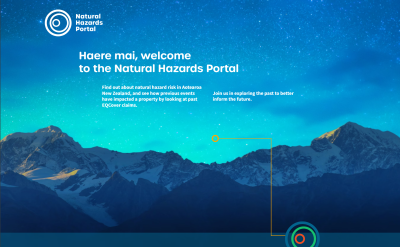Toka Tū Ake EQC launches Natural Hazards Portal
Visit the Natural Hazards Portal.(external link)
Toka Tū Ake EQC has launched a website that makes it easier for New Zealanders to find information on natural hazard risks in their communities. This includes being able to see settled EQCover claims on residential properties and land throughout Aotearoa New Zealand in one place for the first time.

“The Natural Hazards Portal(external link) is part of our commitment to share information that helps people and communities build more resilience to natural hazards,” says Toka Tū Ake EQC Chief Resilience and Research Officer Dr Jo Horrocks.
“We live in a country that has multiple natural hazards, but there are actions we can take to reduce our risk. By helping people understand their natural hazard risks, they can be empowered to make informed decisions to build greater resilience.”
The Portal provides easy access to:
- local and national-level hazard risk information that is available from multiple government agencies, for example, Council hazard maps
- information about natural hazards insurance, and
- a map which allows people to search for settled EQCover claims from 1997 onwards, on residential properties and land nationwide.
The EQCover claims information includes the property address, the natural hazard event date, event type, and the claim type (land or building) of settled EQCover claims from 1997 to present. People can request more detail from Toka Tū Ake EQC under the Official Information Act, as they do now. Claims which are still open and being assessed are not included on the map.
“Sharing information we have about natural hazards is in the public interest,” says Horrocks.
“At Toka Tū Ake EQC, we invest in research and data on natural hazards and ways to reduce risk. We also have decades of claims data that helps us understand the impact of natural hazard events. By making the information more accessible, we’re supporting New Zealanders to build their understanding of natural hazards, and how these have previously affected homes and communities. Seeing this information can also encourage people to ask good questions about whether any damage has been properly repaired, and what they can do to manage their own risks.”
